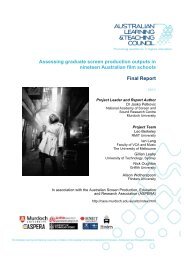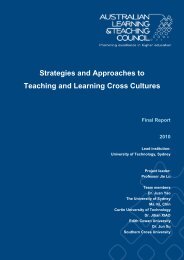PP654 UniSa Freney - Final Report Feb 2010.pdf - Office for ...
PP654 UniSa Freney - Final Report Feb 2010.pdf - Office for ...
PP654 UniSa Freney - Final Report Feb 2010.pdf - Office for ...
Create successful ePaper yourself
Turn your PDF publications into a flip-book with our unique Google optimized e-Paper software.
the time and ef<strong>for</strong>t teaching staff put into the assessment process (“it was fantasticto receive such comprehensive feedback. Since I spent a lot of time on ensuringmy assignments were at a high standard, it was nice to know that course staffmade the ef<strong>for</strong>t to undertake a detailed review of my assignments and providevaluable feedback”). 13Analysis of ResultsStudents are very enthusiastic about online delivery of feedback and assessmentresults. They appreciate that high quality feedback gives them a greater opportunity tolearn and they comment favourably on the ef<strong>for</strong>ts of staff in providing this feedback.Staff liked the ability to easily alter marks/grades using the Slider mechanism(per<strong>for</strong>mance continuum), compose and edit feedback digitally, and reuse feedbackcomments stored in the database. The fact that staff continue to use the systemrein<strong>for</strong>ces the argument <strong>for</strong> CAA systems.These positive results, which were replicated consistently in approximately 30undergraduate courses in which the system was trialled, were the impetus <strong>for</strong>developing the system further and <strong>for</strong> applying <strong>for</strong> funding from the ALTC.7.0 Advancing Existing KnowledgeThe use of ICTs to assist with the provision of feedback and assessment is a growingtrend, which seems logical given the increasing use of eLearning in tertiary education.The CAFAS project contributes and advances the growing body of knowledge reportedin the literature regarding “computer aided marking” 14 , or “computer aided assessment”(CAA) 15 as it is sometimes known. Note that CAFAS is the name (acronym) <strong>for</strong> theparticular system related to this project, whereas CAA is the generic term used in theliterature to discuss a broad range of ICT systems that attempt to aid the assessmentprocess.This project has resulted in a variety of dissemination activities that have advanced theexisting knowledge regarding CAA. The outcomes of the project align with the 2006ALTC program priority of Assessment Practices, in particular: online assessment;assessing large classes; developmental, diagnostic and summative assessment andfeedback to students; and assessing students unfamiliar with assessment practices inAustralian higher education.In 2006 <strong>Freney</strong> and Wood presented evidence to support the argument that provisionof feedback and assessment in digital <strong>for</strong>mat (e.g. via email) improves learning andteaching outcomes 16 . Initial trials using a prototype system of CAFAS, (prior to the13 Wood, D. & <strong>Freney</strong>, M. 2007, pp. 696-697.14 Sondergaard, H & Thomas, D, “Effective feedback to small and large classes”,Proceedings of 34th ASEE/IEEE Frontiers in Education Conference, Session F1E,Savannah: ITEE, 2004.15 Denton, P. “Returning feedback to students via email using electronic feedback”,Learning and Teaching in Action, 2(1), 2003.16 <strong>Freney</strong>, M. & Wood, D. “CAFAS: An automated computer aided assessment tool <strong>for</strong>providing student feedback and managing assessment in<strong>for</strong>mation”, Proceedings of theEvaluations and Assessment Conference, Curtin University of Technology, Perth,Australia, 2006.Computer Aided Feedback & Assessment System (CAFAS) 32
















